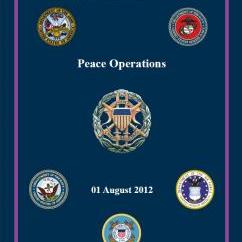
The Department of Defense this week released the 2012 update of its doctrine on "Peace Operations" including new guidance on so-called Mass Atrocity Response Operations that are designed to prevent or halt genocide or other large-scale acts of violence directed at civilian populations.
A mass atrocity consists of "widespread and often systematic acts of violence against civilians by state or non-state armed groups, including killing, causing serious bodily or mental harm, or deliberately inflicting conditions of life that cause serious bodily or mental harm," the updated Pentagon guidance said in Joint Publication 3-07.3
on Peace Operations.
"Mass atrocities can erupt at any time during any operation even in an initially uncontested peacekeeping or humanitarian relief operation," it stated.
Mass Atrocity Response Operations, or MARO, is a newly adopted doctrinal concept that is detailed in Appendix B to the DoD Joint Publication on Peace Operations. The document, dated 01 August 2012, was withheld from online public access on the DoD Joint Electronic Library. But a copy was released to the Federation of American Scientists this week under the Freedom of Information Act.
The MARO concept (and even the term itself) is traceable to an influential advocacy effort by Sarah Sewall and her colleagues at the Harvard Kennedy School over the past several years.
In a 2010 Handbook on MARO, they wrote that "The United States does not currently recognize mass atrocities as a unique operational challenge, and there is no operational concept or doctrine that might help commanders understand the dynamics and demands of responding to mass atrocities. As a result, the US is not fully prepared to intervene effectively in a mass atrocity situation."
Their project aimed to change that state of affairs, and they succeeded to a remarkable extent. "The term MARO is not yet enshrined in military doctrine," they wrote then, "but it should be." And now, with the new Joint Publication on Peace Operations, it is.
(Along the way, in the August 2011 Presidential Study Directive 10, President Obama declared that "Preventing mass atrocities and genocide is a core national security interest and a core moral responsibility of the United States.")
But the Harvard MARO Project was not without critics. Alan J. Kuperman of the University of Texas wrote that the 2010 MARO Handbook emphasized operational issues to the detriment of larger strategic considerations: "Unfortunately, since military intervention can unintentionally increase the likelihood of atrocities, the 'how' of intervention is inextricably linked to debates about 'whether' such action is advisable."
"Since the advent of widespread humanitarian military intervention in the 1990s, such operations have frequently backfired strategically, by increasing civilian suffering, contrary to their political objective," he wrote. ("Mass Atrocity Response Operations: Doctrine in Search of Strategy," Genocide Studies and Prevention, April 2011, pp. 59-65.)
The new DoD doctrine appears cognizant of these ambiguities and countervailing factors, without being to resolve them in any categorical way.
"The PO [peace operations] force may face difficulties when conducting MARO," the doctrine notes, "including the challenge of distinguishing between perpetrator and victim groups when the groups are intermingled, when atrocities are being committed by multiple groups, or when the actions are reciprocal... Because a MARO can alter power balances, former victim groups may be able to conduct their own revenge atrocities.... Many people may be misled into assisting in the commission of atrocities by being convinced that they are acting in self-defense."
"MARO can include unique escalatory dynamics," as further detailed in the Joint Publication. "By pursuing MARO, the PO force may change the dynamics on the ground, leading to the potential for MARO to generate second- and third-order effects, intended or unintended."
These are not issues that can be conclusively settled in military doctrine. "Most of the complexity in MARO -- e.g., how to identify perpetrators, whether to treat the symptoms of the violence and/or the root causes, and the degree of risk to assume in moving swiftly -- should be addressed by interagency mechanisms such as the President's Atrocities Prevention Board."
It will still be up to policymakers "to provide the PO [peace operations] force commander with clear guidance and objectives."
- Login to post comments



Recent comments
9 years 2 weeks ago
9 years 22 weeks ago
9 years 27 weeks ago
9 years 30 weeks ago
9 years 31 weeks ago
11 years 50 weeks ago
12 years 12 weeks ago
12 years 32 weeks ago